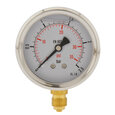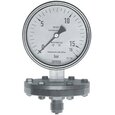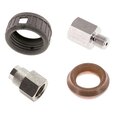Hydraulic pressure gauge
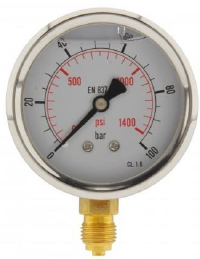
Figure 1: A glycerin-filled hydraulic pressure gauge with steel/brass housing.
A hydraulic pressure gauge is a device that measures and displays the pressure within a hydraulic system. It typically consists of a dial or digital display connected to a sensor that measures the pressure of the fluid. It is used to ensure that the system is operating within safe and accurate parameters. The two main characteristics of hydraulic pressure gauges are that they can measure high pressures and withstand extreme applications due to the liquid-filled gauge. To learn more about pressure gauges, read our pressure gauge overview article.
Table of contents
- Principle of operation
- Liquid-filled gauge
- Scale
- Hydraulic pressure gauge standards
- Selection criteria
- Applications
- FAQs
Pressure gauge online selection
Principle of operation
Hydraulic pressure gauges work on multiple principles like a bourdon tube and bellows gauge.
Bourdon tube
The most common operating principle used in hydraulic pressure gauges is the bourdon tube due to its high accuracy, low cost, and compact design. The bourdon tube is created by flattening a circular cross-section tube and forming a C-shape or helix. One end of the ‘C’ shape is fixed to a block and connected to an inlet pipe for the pressurized fluid, while the other is closed and free to move. They are typically liquid-filled to withstand heavy vibration applications that are common for hydraulic applications.
Bellows pressure gauge
A bellows hydraulic pressure gauge operates similarly to a bourdon tube gauge; however, it utilizes a spring-loaded bellow attached to a calibrated dial to measure fluid pressure. As the fluid pressure fluctuates, the spring expands or compresses, transmitting the force to the gears that rotate the pressure dial, indicating the fluid intensity. Read our article on the bellows pressure gauge for more details on its construction, working principle, and selection criteria.
Liquid-filled gauge
A hydraulic pressure gauge is filled with a liquid, typically glycerin, silicone oil, or mineral oil, to dampen the movement of the gauge's internal components. A liquid-filled gauge has multiple advantages, making it a reliable option for industrial and commercial applications.
- A hydraulic pressure gauge is less affected by vibration than a dry gauge. The liquid helps to dampen the movement of the gauge's internal components, which reduces the effects of vibration and improves the accuracy of the gauge.
- A hydraulic gauge is less affected by temperature changes than a dry gauge. The liquid helps to insulate the gauge's internal components from temperature changes, which reduces the effects of thermal expansion and contraction.
- A liquid-filled pressure gauge also reduces the effects of pressure spikes. As the pressure in the system increases, the liquid in the gauge will compress, helping to absorb the pressure spike and preventing damage to the gauge's internal components.
- Moreover, the liquid-filled pressure gauge is more durable than a dry gauge. The liquid helps to protect the gauge's internal components from corrosion and wear, which increases the lifespan of the gauge. It also helps protect the gauge's internal components from damage caused by dirt, dust, and other contaminants, improving the gauge's reliability and yielding consistent performance.
Scale
- The measurement scale of a hydraulic gauge is typically designed to handle higher pressure ranges and greater accuracy than a standard pressure gauge such as a water gauge or air gauge. Hydraulic systems usually operate at much higher pressures than other system types, and the measurement scale of a hydraulic gauge is designed to handle these high pressures and provide accurate readings. The scale is usually calibrated from 0 to 1000 bar (14503.77 PSI) or more for a hydraulic pressure gauge. The large scaling is usually the most apparent difference between a hydraulic pressure gauge and other gauges, such as water and air gauges.
- The environment in which a hydraulic system operates can be harsh and demanding, with high temperatures, vibration, and pressure spikes. The measurement scale of a hydraulic gauge is designed to withstand these conditions and provide reliable readings over time.
- The measurement scale of a hydraulic gauge is typically designed to handle a more significant number of pressure units than a standard pressure gauge. Hydraulic systems operate under different pressure units, such as PSI, Bar, KPa, and Mpa.
Hydraulic pressure gauge standards
The European Committee for Standards (CEN) has various standards for hydraulic pressure gauges in terms of their definition of terms, specifications, and requirements.
- EN 472: Pressure gauge vocabulary
- EN 837-1: Dimensions, metrology, requirements, and testing of bourdon tube pressure gauges
- EN 837-2: Selection and installation recommendations for pressure gauges
- EN 837-3: Dimensions, metrology, requirements, and testing of diaphragm and capsule pressure gauges
Selection criteria
- Measurement range: The measuring range of a hydraulic pressure gauge is wider than that of water or air gauges. When selecting a pressure gauge for use with hydraulic equipment, it is important to consider the maximum allowed pressure specified by the equipment. Certain hydraulic applications require a high resolution and accuracy, meaning the gauge should be able to measure small changes in pressure. In these cases, a narrower measurement range may be more appropriate. Also, different hydraulic systems may require different measurement ranges. For example, a mobile hydraulic system may have lower pressure requirements than a stationary industrial one.
- Connection size and type: Hydraulic pressure gauges come in different connection sizes. Threaded hydraulic gauges are the most common type. Choose a gauge that fits your holding socket in the hydraulic system.
- Connection material: Hydraulic pressure gauges, such as brass and copper alloy, have different connection materials. Ensure the selected material is compatible with your process and holding socket. Brass is used for non-corrosive media, stainless steel is durable, and plastic is cheap and has corrosion resistance. Please check out our material compatibility chart before you decide.
- Connection location: Possible connection locations can be below, above, or at the rear of the gauge. Consider the available space in your system and how it affects the connection location.
-
Vibration, pulsation, and pressure spikes: Unlike other pressure gauges, hydraulic gauges are often selected based on the capacity to manage the vibrations in the process equipment effectively. Some things to consider are the viscosity and type of filling fluid (water, oil, or glycerin), fluid operating temperature, effect on response time, and the frequency of vibrations expected. Check that the pressure gauge has a mechanism, such as a filling fluid, for handling such operational conditions in hydraulic systems.
- Glycerin is typically used for vibration protection at room temperature
- Silicone oil is standard for high-temperature and extreme-temperature fluctuation applications
- Consider also the type of oil selected if the system is exposed to electrical contacts. Use insulating oil in this case.
- Using a pressure snubber for a pressure gauge is highly recommended in case of pressure spikes and pulsation, which can cause serious damage to the gauge.
- Maximum operating temperature: Most hydraulic pressure gauges work within the 60 – 80 degree celsius (140 - 176 degrees Fahrenheit) temperature range. There are specific hydraulic gauges for high-temperature applications.
- Unit of measurement: It is quite common to have both bar and psi for gauge pressure measurement.
- IP protection: The IP code is essential, especially while using the hydraulic pressure gauge in an environment with dust, condensation, or water splashes. However, higher IP ratings also mean a higher cost for the gauge.
- Digital or dial reading: A digital hydraulic pressure gauge can often transmit the electronic signal as a reading to a remote controller. However, due to cost and simplicity a dial hydraulic pressure gauge is the most common.
Read our article on the selection criteria for pressure gauges for more information on selecting pressure gauges for an application.
Applications
Hydraulic pressure gauges have a wide range of applications.
- Hydraulic presses: In a hydraulic press, the pressure gauge is typically mounted on the control panel of the press or near the press cylinder. The hydraulic press gauge displays the pressure of the oil in the system, allowing the operator to monitor the pressure and make adjustments as necessary.
- Construction equipment: Hydraulic pressure gauges are used in construction equipment such as excavators, bulldozers, and cranes to measure the hydraulic oil pressure in the system. This helps to ensure that the equipment is operating at the correct pressure and that there are no leaks or other issues that could cause damage.
- Control systems: A hydraulic pressure gauge helps measure the pressure on a hydraulic actuator to turn heavy valves.
- Hydraulic pumps: The pressure gauge is used to measure the pressure at the hydraulic pump discharge; As hydraulic systems operate at high pressure, accessing the pump pressure indicates the entire system’s condition (leakages, blockages, etc.) and the possible need for maintenance.
- Lubrication lines: A hydraulic pressure gauge measures the pressure on the supply line of a distributed lubrication system.
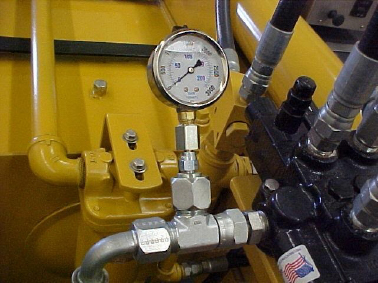
Figure 2: A hydraulic pressure gauge attached to the hydraulic system of a splitter
FAQs
What is a hydraulic PSI gauge?
A hydraulic psi gauge (pounds per square inch gauge) measures the pressure of a fluid in a hydraulic system, specifically in units of Pounds per square inch (PSI).




